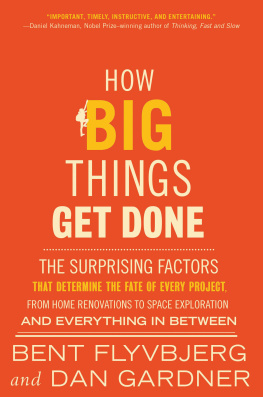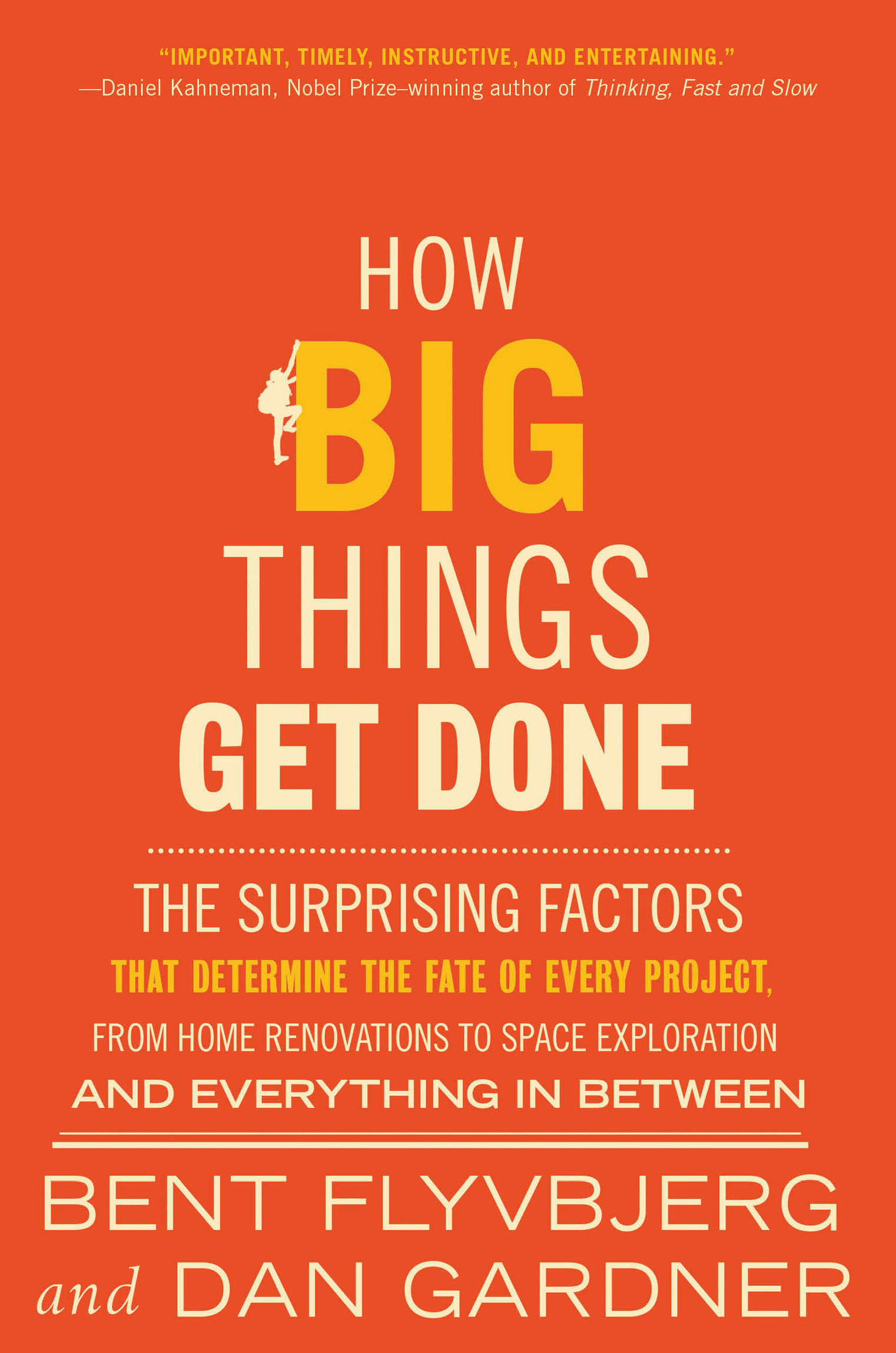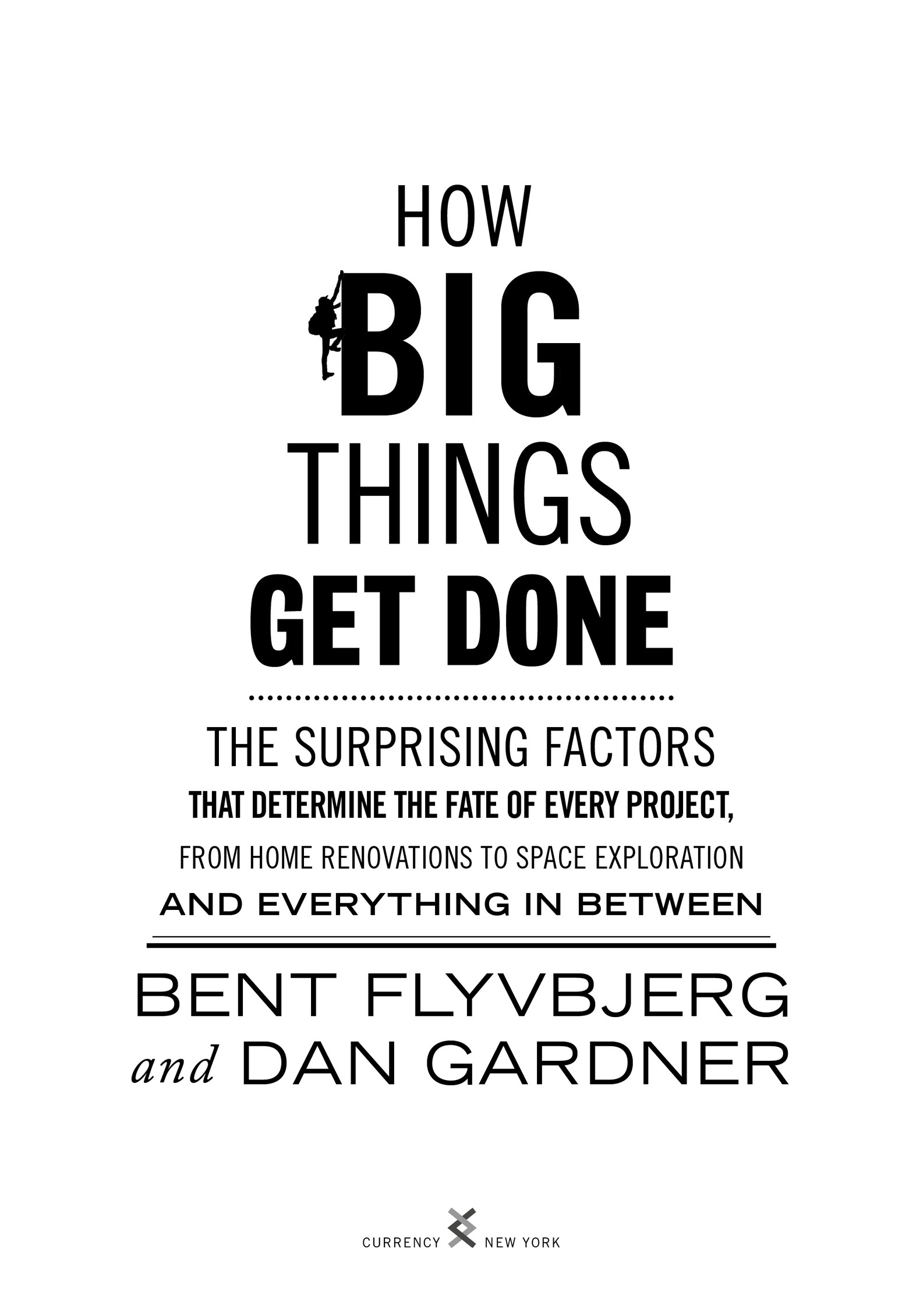Copyright 2023 by Connaught Street Inc. and Bent Flyvbjerg
All rights reserved.
Published in the United States by Currency, an imprint of Random House, a division of Penguin Random House LLC, New York.
Currency and its colophon are trademarks of Penguin Random House LLC.
Names: Flyvbjerg, Bent, author. | Gardner, Dan, author.
Title: How big things get done / Bent Flyvbjerg and Dan Gardner.
Description: First edition. | New York: Currency, [2023] | Includes bibliographical references and index.
Identifiers: LCCN 2022036817 (print) | LCCN 2022036818 (ebook) | ISBN 9780593239513 (hardcover) | ISBN 9780593239520 (ebook)
Subjects: LCSH: Project management.
Classification: LCC HD69.P75 F58 2023 (print) | LCC HD69.P75 (ebook) | DDC 658.404dc23/eng/20220830
Contents
The record of big projects is even worse than it seems.
You need to commit, but not in the way you think.
Start with the most basic question of all: Why?
Plan like Pixar and Frank Gehry do.
Experience is often misunderstood and marginalized.
Think again. Your project is one of those.
Planning ruins projects, some say. But is it true?
Everyone must row in the same direction: toward delivery.
Modularity is the key to building at world-transforming scale.
INTRODUCTION : CALIFORNIA DREAMIN
How is a vision turned into a plan that becomes a triumphant new reality?
Let me tell you a story. You may have heard about it, particularly if you live in California. If you do, youre paying for it.
In 2008, Golden State voters were asked to imagine themselves at Union Station in downtown Los Angeles, on board a sleek silver train. Departing the station, the train slips quietly through the urban sprawl and endless traffic jams and accelerates as it enters the open spaces of the Central Valley, until the countryside is racing by in a blur. Breakfast is served. By the time attendants clear coffee cups and plates, the train slows and glides into another station. This is downtown San Francisco. The whole trip took two and a half hours, not much more than the time it would take the average Los Angeleno to drive to the airport, clear security, and get on a plane to queue on the tarmac, waiting for departure. The cost of the train ticket was $86.
The project was called California High-Speed Rail. It would connect two of the worlds great cities, along with Silicon Valley, the global capital of high technology. Words such as visionary are used too liberally, but this really was visionary. And for a total cost of $33 billion it would be ready to roll by 2020. In a statewide referendum, Californians approved. Work began.
As I write, it is now fourteen years later. Much about the project remains uncertain, but we can be sure that the end result will not be what was promised.
After voters approved the project, construction started at various points along the route, but the project was hit with constant delays. Plans were changed repeatedly. Cost estimates soared, to $43 billion, $68 billion, $77 billion, then almost $83 billion. As I write, the current highest estimate is $100 billion. But the truth is that nobody knows what the full, final cost will be.
In 2019, Californias governor announced that the state would complete only part of the route: the 171-mile section between the towns of Merced and Bakersfield, in Californias Central Valley, at an estimated cost of $23 billion. But when that inland section is completed, the project will stop. It will be up to some future governor to decide whether to launch the project again and, if so, figure out how to get the roughly $80 billionor whatever the number will be by thento extend the tracks and finally connect Los Angeles and San Francisco.
For perspective, consider that the cost of the line between only Merced and Bakersfield is the same as or more than the annual gross domestic product of Honduras, Iceland, and about a hundred other countries. And that money will build the most sophisticated rail line in North America between two towns most people outside California have never heard of. It will beas critics put itthe bullet train to nowhere.
How do visions become plans that deliver successful projects? Not like this. An ambitious vision is a wonderful thing. California was bold. It dreamed big. But even with buckets of money, a vision is not enough.
Let me tell you another story. This one is unknown, but I think it gets us closer to the answers we need.
In the early 1990s, Danish officials had an idea. Denmark is a small country with a population less than New York Citys, but it is rich and gives a lot of money in foreign aid and wants that money to do good. Few things do more good than education. The Danish officials got together with colleagues from other governments and agreed to fund a school system for the Himalayan nation of Nepal. Twenty thousand schools and classrooms would be built, most of them in the poorest and most remote regions. Work would begin in 1992. It would take twenty years.
The history of foreign aid is littered with boondoggles, and this project could easily have added to the mess. Yet it finished on budget in 2004eight years ahead of schedule. In the years that followed, educational levels rose across the country, with a long list of positive consequences, particularly a jump in the number of girls in classrooms. The schools even saved lives: When a massive earthquake struck Nepal in 2015, almost nine thousand people died, with many being crushed to death in collapsing buildings. But the schools had been designed to be earthquake proof, as a first. They stood. Today, the Bill & Melinda Gates Foundation uses the project as an exemplar of how to improve health by increasing enrollment in schools, particularly for girls.
I was the planner on that project. At the time, I was pleased with how it turned out, but I didnt think much about it. It was my first big project, and, after all, we only did what we had said we would do: turn a vision into a plan that was delivered as promised.
However, in addition to being a planner, I am an academic, and the more I studied how big projects come togetheror fail tothe more I understood that my experience in Nepal was not normal. In fact, it was not remotely normal. As well see, the data show that big projects that deliver as promised are rare. Normal looks a lot more like California High-Speed Rail. Average practice is a disaster, best practice an outlier, as I would later point out in my findings about megaproject management.
Why is the track record of big projects so bad? Even more important, what about the rare, tantalizing exceptions? Why do they succeed where so many others fail? Had we just been lucky delivering the schools in Nepal? Or could we do it again? As a professor of planning and management, Ive spent many years answering those questions. As a consultant, Ive spent many years putting my answers into practice. In this book, Im putting them into print.











